General Information
ICG Labeling Kit - NH2 is primarily used for the preparation of ICG (Indocyanine green)-labeled antibody for near-infrared fluorescence imaging. ICG is approved to be used in clinical fi eld such as a hepatic defi ciency test, and has near-infrared fluorescence lasting a few days under physiological conditions. Fluorescence detection in near-infrared region is very popular due to the lower background fluorescence. Therefore, ICG and ICG conjugates are suitable materials for in vivo imaging. NH2-Reactive ICG, a component of this kit, has a succinimidyl ester group, and can easily make a covalent bond with an amino group of the target protein without any activation process. Filtration Tube included in this kit is used for sample protein in removing small molecules such as amine compounds that interfere with a labeling reaction.The labeling process is very simple. Add the NH2-Reactive ICG to protein solution on a fi lter membrane, and incubate at 37°C for 10 min. Excess ICG molecules can be removed by a fi ltration tube.
The excitation and emission wavelengths of the ICG-labeled proteins are 774 nm and 805 nm, respectively.
Kit Contents
| 【3 samples】 | |
| NH2-Reactive ICG | 3 tubes |
| WS Buffer | 4 ml × 1 |
| Reaction Buffer | 500μl × 1 |
| Filtration Tube | 3 tubes |
Capacity
Sample requirement : molecular weight > 50,000; amount: 50-200 μg
Storage Condition
Store at 0-5°C. This kit is stable for 1 year at 0-5°C before opening.
|
Caution After a NH2-Reactive ICG is taken out from the seal bag, keep the unused NH2-Reactive ICG (s) in the bag, seal tightly and store at -20°C. Store the other components at 0-5°C. |
Required Equipment
- 10 μl and 200 μl adjustable pipettes
- Incubator (37°C)
- Microtubes
- Microcentrifuge
- DMSO
- PBS
Precaution
- If the target protein solution contains other proteins with molecular weight larger than 10,000, such as serum albumin or gelatin, purify the protein solution, and use the purifi ed target proteins for ICG labeling, because it might interfere the labeling reaction.
- If the protein solution contains small insoluble materials, centrifuge the solution, and use the supernatant for the labeling.
- The droplets which induced from the dry inhibitor of membrane, are occasionally found inside Filtration Tube while storing the kit at 0-5°C or after returning to room temperature. This phenomenon does not affect the performance.
- This kit includes microtubes containing solutions. Since there is a possibility that the droplets might attach to the inside walls or
- caps, please shake them down prior to open.
General Protocol for protein labeling
-
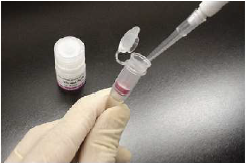
Step 1.
Add 100 μl WS Buffer and the sample solution containing 50-200 μg proteina) to a Filtration Tube.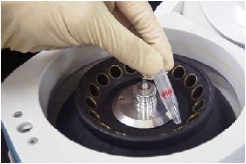
Step 2.
Mix the solution with pipetting several times, and centrifuge at 8,000 x g for 15 min.b)
-
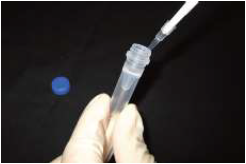
Step 3.
Add 10 μl DMSO to NH2-Reactive ICG, and dissolve with pipetting.c)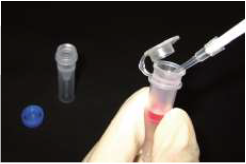
Step 4.
Add 100 μl Reaction Buffer to the Filtration tube, and then add 8 μl NH2-Reactive ICG solutiond) to the Filtration Tube and pipette to mix.
-
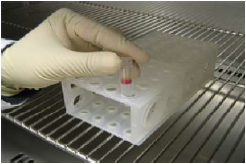
Step 5.
Incubate the tube at 37°C for 10 min.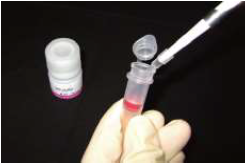
Step 6.
Add 100 μl WS Buffer to the Filtration Tube, and centrifuge at 8,000 x g for 15 min.b) Discard the fi ltrate.
-
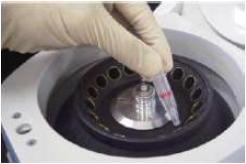
Step 7.
Add 200 μl WS Buffer to the Filtration Tube, and centrifuge at 8,000 x g for 15 min.b) Repeat this step one more time.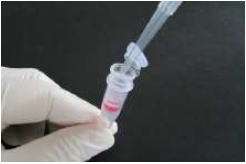
Step 8.
Add 200 μl PBS, and pipette about 10 times to recover the conjugate.e)
Transfer the solution to a microtube (not included in this kit), and store at 0-5°C.
a) The volume of protein solution should be less than 100 μl. If the antibody concentration is lower than 0.5 mg/ml, repeat Steps 1 and 2 until the total protein accumulation becomes 50-200 μg.
b) If the solution still remains on the membrane after the centrifugation, centrifuge for another 5 min.
c) NH2-Reactive ICG is on the bottom of the tube. Add 10 μl DMSO to the bottom of the tube, and pipette several times to dissolve. NH2-Reactive ICG can be hydrolyzed by moisture in DMSO. Proceed to Step 4. immediately after the preparation of the NH2-Reactive ICG solution.
d) If the amount of protein is 200 μg, add entire NH2-Reactive ICG solution.
e) You can use an appropriate buffer for the downstream experiments.
Determination of Dye / protein Ratio
Dilute the ICG-labeled protein solution with PBS or other neutral buffers to a proper volume, and measure the absorbance of the protein solution at 280 nm and 800 nm. Calculate the ratio using the following equation: When a target protein is IgG, use 216,000 as the ε of protein. Molar absorption coeffi cient of ICG in PBS is 147,000.
-
Ratio (ICG / protein)= A800 /147,000 (A280 - A800 x 0.075)/(ε of protein)
- A800: absorbance at 800 nm
A280: absorbance at 280 nm
ε: molar absorption coeffi cient of protein at 280 nm
Labeling Reaction

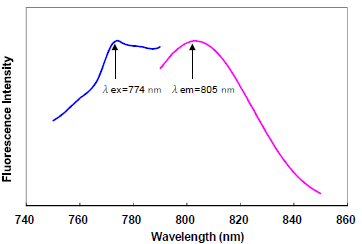
Excitation and Emission Spectra of ICG
Q & A
Can I use this kit to label antibodies which is commercially available?
Yes. However, if the antibody solution contains other proteins such as serum albumin or gelatin, labeling reaction might be interefered by that protein. Purifi cation of the antibody solution with affi nity chromatography is necessary prior to using this kit.
Contact us for the purifi cation procedure, if you need.
How long is the ICG-labeled protein stable?
Stability of conjugate depends on the protein itself. Please use the conjugate as soon as possible. For long term storage, aliquot and store the sample solution at -20°C.
How many ICG molecules are introduced to protein?
The number of conjugated ICG depends on the protein. In the case of rabbit IgG, one molecule of ICG conjugate to each protein molecule.
Can I use this kit to label oligonucleotides or oligopeptides?
No. Oligonucleotides and oligopeptides may be too small to retain on the membrane fi lter of Filtration Tube.
Frequently Asked Questions / Reference
LK31: ICG Labeling Kit - NH2
Revised Mar., 27, 2024


 Hidden sections will not be printed.
Hidden sections will not be printed.